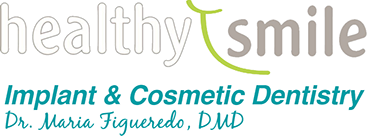Procedures and Services
Dental implants
Dental implants are a great way to replace missing teeth and also provide a fixed solution to having removable partial or complete dentures. Implants provide excellent support and stability for these dental appliances.
Dental Implants are root formed titanium screws that are surgically placed into the upper or lower jaw bone. Then over these implants the final restoration is placed. The teeth attached to implants are very natural looking and often enhance or restore a patient smile.
Reasons for dental implants:
- Replace one or more missing teeth without affecting adjacent teeth
- Resolve joint pain or bite problems caused by teeth shifting into missing tooth space
- Restore a patient’s confident smile
- Restore chewing, speech and digestion
- Restore and enhance facial tissues
- Support a bridge or denture, making them more secure and comfortable
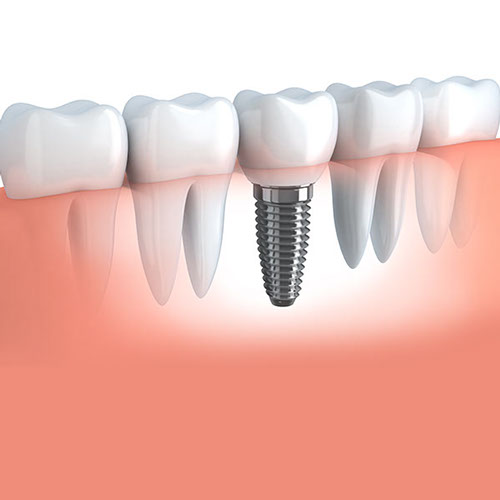
A common misconception regarding dental implants is that implant placement or post-operative (healing and recovery) are painful. Actually they in most cases are less or non symptomatic than other more conventional dental treatments, like extractions or root canal therapy. As any surgery some swelling, bruising and numbness can be expected. All this will be eased with anti-inflammatory/analgesic medication Dr Figueredo will prescribe for you. Dr Figueredo also will prescribe antibiotic regime to prevent infection of the treated area
Who’s a candidate for dental implants
In general, every patient that has missing teeth and a stable/controlled medical history is candidate for dental implants. The quality and quantity of bone which will harbor the implant(s) is an important factor in the planning of the case. In those cases where the bone conditions are appropriate the site is just ready to place the implant. There are other cases where there is not enough bone, usually because extractions were done long time ago. In these areas bone can be grafted and after a certain healing time (integration time) (3 to 7 months) site will be ready for the dental implant.
When a tooth is planned to be extracted, the ideal scenario is to graft the socket with bone so by the time of implant placement there will be appropriate bone thickness and height. When the implant is placed in, again, it requires an integration time that varies from areas in the mouth, but ranges between 3 to 5 months.
After this period, the restoration process begins. An abutment is selected, an impression is made of it and a crown is made to place in. If the implants will be to retain a complete or a partial denture, then the processing of the denture(s) begins.
Bone Grafting
Is the process in which bone is implanted over, around or inside the alveolar bone.
The bone used could become from different sources. You can discuss this with Dr Figueredo to determine what would be the best for you.
It is recommended that all extraction sockets be grafted with bone; no matter what will be the final restoration to replace the missing tooth/teeth. This not only makes healing less painful, but also maintains ridge support so aesthetic, support, stability and function of final restoration will be better.

Cosmetic Dentistry/Smile Makeover
A Smile Makeover refers to any combination of cosmetic dental procedures that enhances the beauty and appearance of the smile, correcting almost any problem. In a smile makeover we can straight crooked teeth, repair chipped or broken teeth, replace missing teeth, close gaps between teeth, recontour gummy smiles (too much gum shown when smiling)and white discolored or stained teeth; so you can get a straight, white and even smile.
Bonding
Bonding refers to the technique of using composite resin to restore teeth. Composite Resin is a biocompatible and gentle tooth colored restoration material. Composite dental bonding is one of the simplest and most conservative ways of masking minor imperfections in your smile such as cracks, chips, gaps and discoloration. Bonding can also be used to restore cavities. After meticulous removal of decay, tooth is prepared to receive and bond the tooth colored restoration material.

Crowns
Also called caps. They are natural looking covers that fit snugly over teeth to conceal cracked, discolored, injured, chipped or Root Canal treated teeth. Crowns provide support and protection to damaged teeth, so they are more resistant to injury. Some indications for crowns are:
- Broken or fractured teeth
- Cosmetic enhancement
- Severely decayed teeth
- Fractured fillings
- Large fillings
- Previous Root Canal Therapy
Crowns can be made out of porcelain or porcelain fused to metal. The aesthetic results we can get with all porcelain crowns are incredibly amazing!
Bridges
If you are missing teeth, having trouble speaking or chewing, or notice strain when biting; bridges may be the ideal option to help make your mouth healthy and beautiful again. Bridges are often called Fixed Partial Dentures. Bridges literally bridge gaps between teeth by filling them with strong, natural looking artificial teeth. Bridges are permanent restorations and can only be removed by a dentist, they are completely comfortable and proven to make teeth strong.
Veneers
They are an excellent alternative to crowns, they can perfect your smile by masking stains, hiding chips, correcting misalignment and creating uniformity. Veneers, which are made of thin customized porcelain, are designed to slide over the teeth, they look incredibly natural, are long lasting and relatively easy to apply. They result in a less tooth invasive procedure.
Lumineers
These restorations are similar to veneers with similar indications (cosmetic smile makeovers). The main difference is that Lumineers are even thinner than veneers, so with minimal or in some cases none tooth structure removal you can get the beautiful smile you dream with.
Teeth Whitening
In office or take home non invasive procedure to remove stains from enamel to result in a brighter, whiter smile! Treatment could last about one hour and results are appreciated immediately.
“Prevention is always better than treatment”
There are several services our office provides in order to prevent future dental complications, just as:
- Broken or fractured teeth
- Cosmetic enhancement
- Severely decayed teeth
- Fractured fillings
- Large fillings
- Previous Root Canal Therapy
Sealant
A dental sealant is a professionally-applied material that is put on the chewing surfaces of molars (back teeth) to prevent cavities in such surfaces by blocking out the anatomic pits and fissures and prevent bacteria to harbor in.

Periodontal Treatment (Gum Disease)
Periodontal treatment is done when the patient has the so commonly called “gum disease”, which proper name is Periodontal Disease (PD). PD is an infectious process that affects the periodontium –surrounding structures of the teeth, mainly gum and supporting bone-. PD is characterized by the accumulation of a bacterial biofilm (plaque and calculus) around teeth over and under gingival level. This is manifested as swelling, erythema (redness) and bleeding of gums; sometimes there could be purulent exudates and soreness as well. Halitosis (bad breath) and teeth mobility are also signs of PD. The main long term consequence of PD is resorption of supporting bone due to the infectious process occurring subgingivally. This leads to mobility and finally loosening of teeth.
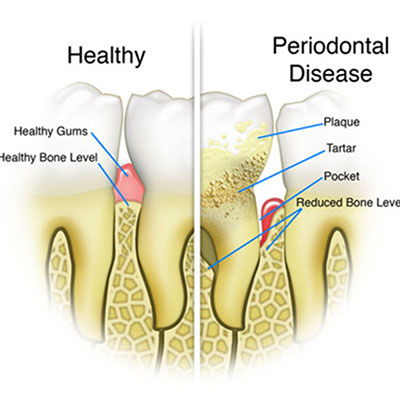
Scaling & Root Planning
The first line of treatment for PD is Scaling and Root Planning (SRP) commonly known as deep cleaning. SRP consists in meticulously remove contaminant toxins, micro-organisms, plaque, tartar, cement and dentin that is rough and/or permeated by calculus from around, below and under the gum line to the bottom of the pocket. The results of treatment are improved when after SRP clean empty pockets are treated with local antibiotic therapy. In our office we apply a tetracycline derivative that has an enormous effectiveness in the healing process.
In cases where Periodontal Disease is in a Severe Stage a second line of treatment will be needed in order to improve teeth and periodontium prognosis. The second line of treatment usually involves periodontal surgery, that will be done by an specialist, the periodontist.
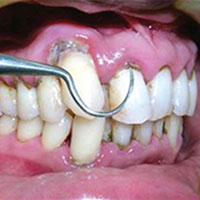
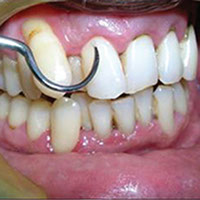
Before

After
Sedation Dentistry
Periodontal treatment is done when the patient has the so commonly called “gum disease”, which proper name is Periodontal Disease (PD). PD is an infectious process that affects the periodontium –surrounding structures of the teeth, mainly gum and supporting bone-. PD is characterized by the accumulation of a bacterial biofilm (plaque and calculus) around teeth over and under gingival level. This is manifested as swelling, erythema (redness) and b
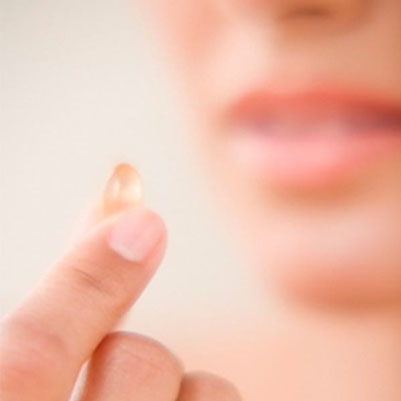
Pediatric Dentistry
Dr Maria Figueredo treats patients of any age.
Dental procedures commonly done in pediatric patients:
Sealants
- Cleaning
- Fluoride rinse for decay prevention
- Bonding for cosmetic and to restore decayed teeth
- Extractions of primary (baby) and permanent teeth
- Orthodontics phase I and II
Habit Breakers
Appliance to help kid quit thumb sucking, nails biting or tongue trusting habits.
Frenulectomy

- Sublingual Simple low invasive surgery to cut sublingual frenum when its insertion is so forward in the tongue that doesn’t allow kid to pronounce the sound of “R” properly.
- Sublabial Simple low invasive surgery to cut sublabial frenum when its insertion is so high that causes central teeth to separate
pulpotomy
When there has been decay so deep that has caused pulpal infection of a deciduous tooth a pulpectomy (removal of blood vessels and nerve bundle inside of tooth) is indicated. The pulpectomy can be partial or complete.
In a Partial or Vital Pulpotomy only a part of the pulpal bundle is removed and the rest of it is left intact.
In a Complete or Non Vital Pulpotomy the whole pulpal bundle is removed and the canal is sealed, just like a Root Canal Therapy of a permanent tooth.
Apexogenesis/ Apexifications
These are procedures done when a permanent but not mature tooth needs Root Canal Therapy.
Orthodontics
Phase I and Phase II
TMD (Temporomandibular Disorder)
Phase 1 Orthodontic Treatment
Phase I or early orthodontic treatment consist in treating the kid early when still there are deciduous teeth (baby teeth) present and could be some permanent teeth already erupted. In these cases Dr Figueredo will analyze and project the growth pattern of the patient and with the help of a variety of appliances will guide the in process growing into a desirable result in such a way that in future when all permanent teeth erupt the orthodontic treatment will be easier, less expensive, shorter, less traumatic and less invasive. In occasions it could even eliminate the need of conventional orthodontics (brackets). It could also prevent the need of orthognatic surgery.
Retrognatic Mandibule (lower jaw way far backward), thumb sucking and tongue trusting habit and related malformations, space problems, prognatic profile (lower jaw more forward than upper jaw) are some of the conditions Dr. Figueredo is well trained to treat successfully.
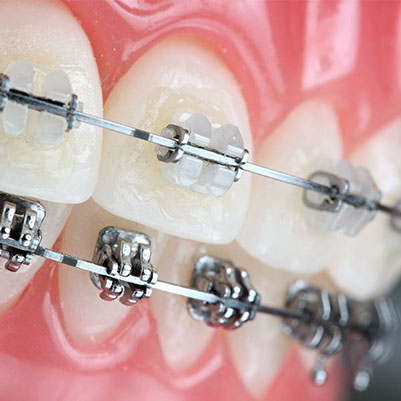
Phase 2 Orthodontic Treatment
Also known as straight wire or conventional orthodontic. With brackets (braces), wires and ligatures Dr Figueredo will align crooked and/or rotated teeth, make space for crowded and/or impacted teeth and develop the arches to form a broad cosmetic smile. These treatments usually last between 18 and 24 months. There could be some shorter cases lasting 12-15 months.
In Phase II or conventional orthodontics Dr could make use of some appliances to:
- Develop or expand the arches orthopedically
- Move premaxilla forward (in cases of maxillary deficiency, which presents visually as a short upper
- jaw compared to a normal lower jaw)
- Move mandibule forward (in cases of retrognatic mandibule, which presents visually as a short lower
- jaw compared to a normal upper jaw)
Sometimes in cases of severe crowding and normal size and position of upper and lower jaws, extraction of teeth is required to achieve proper alignment. The most common teeth extracted are the first bicuspids, which are the little molars just behind the canines.
Phase II orthodontics has no age limitation. As it is not an invasive treatment it can be performed in pregnant patients and patients under medical treatments.
Dr Figueredo offers metallic low profile brackets (smallest brackets in the market), clear or ceramic brackets and clear liners. The time of treatment could vary depending on what will be used.
TMD (Temporomandibular Disorders)
TMD is referred to a series of disorders or disfunctions of the temporomandibular joint.
Dr Figueredo has been trained to treat early and intermediate stage of TMD.
Most cases of TMD are related to malocclusions (incorrect biting pattern). The most common malocclusions that affect TMJ negatively are:
- Constricted maxilla (constricted upper jaw)
- Deep bite
- Retrognatic mandibule (lower jaw positioned backward)
All these can be treated successfully with phase II orthodontics. But sometimes it may also required a splint therapy for several of months (4-10 months) and then phase II orthodontics.

Root Canal Therapy (RCT)
In the situation that a tooth has decay or fracture so deep close to or into the pulp, causing an irreversible pathology of the pulp; a pulpectomy (removal of pulp tissue) is done. The pulp is the bundle of blood vessels and nerves contained inside of a tooth. As a consequence of a pulpectomy or RCT the tooth becomes dry from the inside, this process makes the tooth more brittle and prone to fracture. It is because of this that dentists recommend a Post and Core or reconstruction followed by a crown, so tooth will be protected.
It is very important before making the decision to proceed with a RCT determine if later the tooth is restorable with a reasonable prognosis (Prognosis refers to the long term success of the tooth). If tooth won’t be restorable or for any reason prognosis is uncertain, it could be a better alternative extract the tooth.
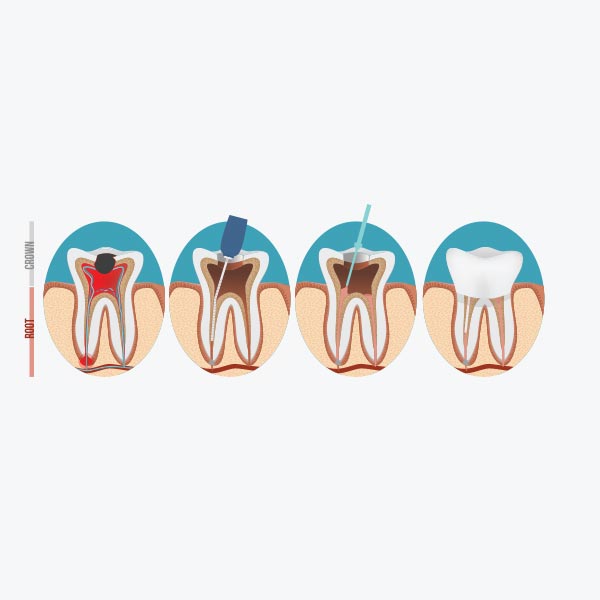
Extractions
Extractions are performed for a wide variety of reasons. Tooth decay that has destroyed enough tooth structure to prevent restoration is the most frequent indication for extraction of teeth. Extractions of impacted or problematic wisdom teeth are routinely performed, as are extractions of some permanent teeth to make space for orthodontic treatment.
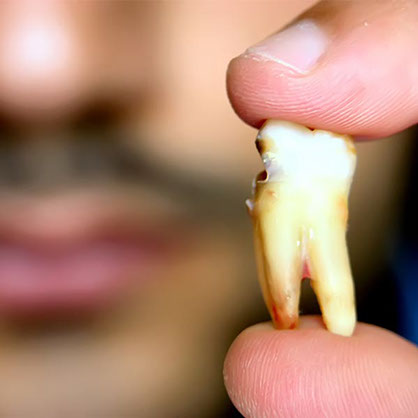
Fixed Restorations
Fixed Restoration refers to any dental restoration that patient does not have to take out to clean, adjust o sleep at all. Among Fixed Restorations Dr Figueredo offers you are: all porcelain crowns, porcelain fused to metal crowns (porcelain outside and metal underneath), veneers, lumineers, all porcelain and porcelain fused to metal bridges and dental implants.
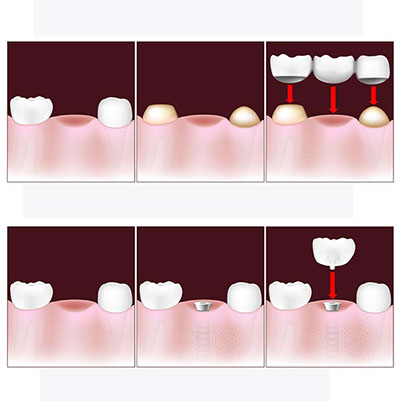
Removable Dentures
Dentures can be partial or complete. A Partial Denture is made when there are still some teeth in the arch. Actually they serve as support for the denture. Partial Dentures could be metal-acrylic and metal free or flexible. The indications for them would vary depending on what are the remaining present teeth and their conditions.
Complete Dentures are made when there are not remaining teeth in the arch. The stability of removable dentures sometimes could become an issue for patients comfort. This can be improved with implants.
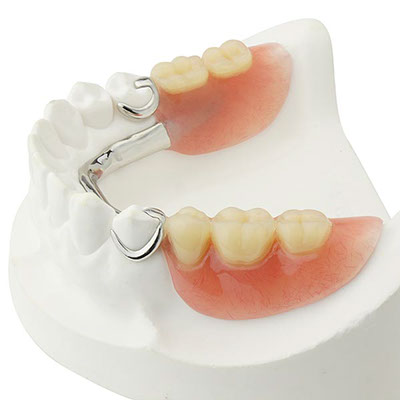
Teeth Whitening
Many of us feel that our smiles are more striking when our teeth look specially white, unfortunately soft drinks, coffee, tea, wine, tobacco and dark sauces can leave ugly stains. These stains accumulate in the enamel (outermost layer of teeth) pores. During the whitening procedure the accumulated stains are dissolved by the indicated professional product which is activated by an special lamp. This process will result in the removal of stains over enamel.
Contrary to the common misconception that teeth whitening is a very aggressive or invasive procedure; it is NOT. It only remove stains. It does not affect the composition of your teeth. It does not damage the pulp (nerve). It is pretty much like a micro-cleaning of the enamel. Due to the process, teeth may become a little dry and pores are empty of stains, this could result in some post-operative sensitivity; for which Dr Figueredo will guide you on what to do and not to do to avoid post-operative discomfort and to enjoy your new whiter smile for long time !
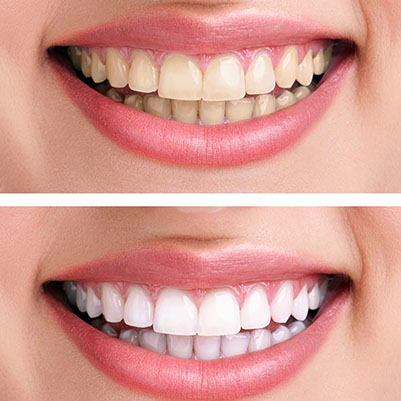
Procedures and Services
Dental implants
Dental implants are a great way to replace missing teeth and also provide a fixed solution to having removable partial or complete dentures. Implants provide excellent support and stability for these dental appliances.
Dental Implants are root formed titanium screws that are surgically placed into the upper or lower jaw bone. Then over these implants the final restoration is placed. The teeth attached to implants are very natural looking and often enhance or restore a patient smile.
Reasons for dental implants:
- Replace one or more missing teeth without affecting adjacent teeth
- Resolve joint pain or bite problems caused by teeth shifting into missing tooth space
- Restore a patient’s confident smile
- Restore chewing, speech and digestion
- Restore and enhance facial tissues
- Support a bridge or denture, making them more secure and comfortable

A common misconception regarding dental implants is that implant placement or post-operative (healing and recovery) are painful. Actually they in most cases are less or non symptomatic than other more conventional dental treatments, like extractions or root canal therapy. As any surgery some swelling, bruising and numbness can be expected. All this will be eased with anti-inflammatory/analgesic medication Dr Figueredo will prescribe for you. Dr Figueredo also will prescribe antibiotic regime to prevent infection of the treated area
Who’s a candidate for dental implants
In general, every patient that has missing teeth and a stable/controlled medical history is candidate for dental implants. The quality and quantity of bone which will harbor the implant(s) is an important factor in the planning of the case. In those cases where the bone conditions are appropriate the site is just ready to place the implant. There are other cases where there is not enough bone, usually because extractions were done long time ago. In these areas bone can be grafted and after a certain healing time (integration time) (3 to 7 months) site will be ready for the dental implant.
When a tooth is planned to be extracted, the ideal scenario is to graft the socket with bone so by the time of implant placement there will be appropriate bone thickness and height. When the implant is placed in, again, it requires an integration time that varies from areas in the mouth, but ranges between 3 to 5 months.
After this period, the restoration process begins. An abutment is selected, an impression is made of it and a crown is made to place in. If the implants will be to retain a complete or a partial denture, then the processing of the denture(s) begins.
Bone Grafting
Is the process in which bone is implanted over, around or inside the alveolar bone.
The bone used could become from different sources. You can discuss this with Dr Figueredo to determine what would be the best for you.
It is recommended that all extraction sockets be grafted with bone; no matter what will be the final restoration to replace the missing tooth/teeth. This not only makes healing less painful, but also maintains ridge support so aesthetic, support, stability and function of final restoration will be better.

Cosmetic Dentistry/Smile Makeover
A Smile Makeover refers to any combination of cosmetic dental procedures that enhances the beauty and appearance of the smile, correcting almost any problem. In a smile makeover we can straight crooked teeth, repair chipped or broken teeth, replace missing teeth, close gaps between teeth, recontour gummy smiles (too much gum shown when smiling)and white discolored or stained teeth; so you can get a straight, white and even smile.
Bonding
Bonding refers to the technique of using composite resin to restore teeth. Composite Resin is a biocompatible and gentle tooth colored restoration material. Composite dental bonding is one of the simplest and most conservative ways of masking minor imperfections in your smile such as cracks, chips, gaps and discoloration. Bonding can also be used to restore cavities. After meticulous removal of decay, tooth is prepared to receive and bond the tooth colored restoration material.

Crowns
Also called caps. They are natural looking covers that fit snugly over teeth to conceal cracked, discolored, injured, chipped or Root Canal treated teeth. Crowns provide support and protection to damaged teeth, so they are more resistant to injury. Some indications for crowns are:
- Broken or fractured teeth
- Cosmetic enhancement
- Severely decayed teeth
- Fractured fillings
- Large fillings
- Previous Root Canal Therapy
Crowns can be made out of porcelain or porcelain fused to metal. The aesthetic results we can get with all porcelain crowns are incredibly amazing!
Bridges
If you are missing teeth, having trouble speaking or chewing, or notice strain when biting; bridges may be the ideal option to help make your mouth healthy and beautiful again. Bridges are often called Fixed Partial Dentures. Bridges literally bridge gaps between teeth by filling them with strong, natural looking artificial teeth. Bridges are permanent restorations and can only be removed by a dentist, they are completely comfortable and proven to make teeth strong.
Veneers
They are an excellent alternative to crowns, they can perfect your smile by masking stains, hiding chips, correcting misalignment and creating uniformity. Veneers, which are made of thin customized porcelain, are designed to slide over the teeth, they look incredibly natural, are long lasting and relatively easy to apply. They result in a less tooth invasive procedure.
Lumineers
These restorations are similar to veneers with similar indications (cosmetic smile makeovers). The main difference is that Lumineers are even thinner than veneers, so with minimal or in some cases none tooth structure removal you can get the beautiful smile you dream with.
Teeth Whitening
In office or take home non invasive procedure to remove stains from enamel to result in a brighter, whiter smile! Treatment could last about one hour and results are appreciated immediately.
“Prevention is always better than treatment”
There are several services our office provides in order to prevent future dental complications, just as:
- Broken or fractured teeth
- Cosmetic enhancement
- Severely decayed teeth
- Fractured fillings
- Large fillings
- Previous Root Canal Therapy
Sealant
A dental sealant is a professionally-applied material that is put on the chewing surfaces of molars (back teeth) to prevent cavities in such surfaces by blocking out the anatomic pits and fissures and prevent bacteria to harbor in.

Periodontal Treatment (Gum Disease)
Periodontal treatment is done when the patient has the so commonly called “gum disease”, which proper name is Periodontal Disease (PD). PD is an infectious process that affects the periodontium –surrounding structures of the teeth, mainly gum and supporting bone-. PD is characterized by the accumulation of a bacterial biofilm (plaque and calculus) around teeth over and under gingival level. This is manifested as swelling, erythema (redness) and bleeding of gums; sometimes there could be purulent exudates and soreness as well. Halitosis (bad breath) and teeth mobility are also signs of PD. The main long term consequence of PD is resorption of supporting bone due to the infectious process occurring subgingivally. This leads to mobility and finally loosening of teeth.

Scaling & Root Planning
The first line of treatment for PD is Scaling and Root Planning (SRP) commonly known as deep cleaning. SRP consists in meticulously remove contaminant toxins, micro-organisms, plaque, tartar, cement and dentin that is rough and/or permeated by calculus from around, below and under the gum line to the bottom of the pocket. The results of treatment are improved when after SRP clean empty pockets are treated with local antibiotic therapy. In our office we apply a tetracycline derivative that has an enormous effectiveness in the healing process.
In cases where Periodontal Disease is in a Severe Stage a second line of treatment will be needed in order to improve teeth and periodontium prognosis. The second line of treatment usually involves periodontal surgery, that will be done by an specialist, the periodontist.


Before

After
Sedation Dentistry
Periodontal treatment is done when the patient has the so commonly called “gum disease”, which proper name is Periodontal Disease (PD). PD is an infectious process that affects the periodontium –surrounding structures of the teeth, mainly gum and supporting bone-. PD is characterized by the accumulation of a bacterial biofilm (plaque and calculus) around teeth over and under gingival level. This is manifested as swelling, erythema (redness) and b

Pediatric Dentistry
Dr Maria Figueredo treats patients of any age.
Dental procedures commonly done in pediatric patients:
Sealants
- Cleaning
- Fluoride rinse for decay prevention
- Bonding for cosmetic and to restore decayed teeth
- Extractions of primary (baby) and permanent teeth
- Orthodontics phase I and II
Habit Breakers
Appliance to help kid quit thumb sucking, nails biting or tongue trusting habits.
Frenulectomy

- Sublingual Simple low invasive surgery to cut sublingual frenum when its insertion is so forward in the tongue that doesn’t allow kid to pronounce the sound of “R” properly.
- Sublabial Simple low invasive surgery to cut sublabial frenum when its insertion is so high that causes central teeth to separate
pulpotomy
When there has been decay so deep that has caused pulpal infection of a deciduous tooth a pulpectomy (removal of blood vessels and nerve bundle inside of tooth) is indicated. The pulpectomy can be partial or complete.
In a Partial or Vital Pulpotomy only a part of the pulpal bundle is removed and the rest of it is left intact.
In a Complete or Non Vital Pulpotomy the whole pulpal bundle is removed and the canal is sealed, just like a Root Canal Therapy of a permanent tooth.
Apexogenesis/ Apexifications
These are procedures done when a permanent but not mature tooth needs Root Canal Therapy.
Orthodontics
Phase I and Phase II
TMD (Temporomandibular Disorder)
Phase 1 Orthodontic Treatment
Phase I or early orthodontic treatment consist in treating the kid early when still there are deciduous teeth (baby teeth) present and could be some permanent teeth already erupted. In these cases Dr Figueredo will analyze and project the growth pattern of the patient and with the help of a variety of appliances will guide the in process growing into a desirable result in such a way that in future when all permanent teeth erupt the orthodontic treatment will be easier, less expensive, shorter, less traumatic and less invasive. In occasions it could even eliminate the need of conventional orthodontics (brackets). It could also prevent the need of orthognatic surgery.
Retrognatic Mandibule (lower jaw way far backward), thumb sucking and tongue trusting habit and related malformations, space problems, prognatic profile (lower jaw more forward than upper jaw) are some of the conditions Dr. Figueredo is well trained to treat successfully.

Phase 2 Orthodontic Treatment
Also known as straight wire or conventional orthodontic. With brackets (braces), wires and ligatures Dr Figueredo will align crooked and/or rotated teeth, make space for crowded and/or impacted teeth and develop the arches to form a broad cosmetic smile. These treatments usually last between 18 and 24 months. There could be some shorter cases lasting 12-15 months.
In Phase II or conventional orthodontics Dr could make use of some appliances to:
- Develop or expand the arches orthopedically
- Move premaxilla forward (in cases of maxillary deficiency, which presents visually as a short upper
- jaw compared to a normal lower jaw)
- Move mandibule forward (in cases of retrognatic mandibule, which presents visually as a short lower
- jaw compared to a normal upper jaw)
Sometimes in cases of severe crowding and normal size and position of upper and lower jaws, extraction of teeth is required to achieve proper alignment. The most common teeth extracted are the first bicuspids, which are the little molars just behind the canines.
Phase II orthodontics has no age limitation. As it is not an invasive treatment it can be performed in pregnant patients and patients under medical treatments.
Dr Figueredo offers metallic low profile brackets (smallest brackets in the market), clear or ceramic brackets and clear liners. The time of treatment could vary depending on what will be used.
TMD (Temporomandibular Disorders)
TMD is referred to a series of disorders or disfunctions of the temporomandibular joint.
Dr Figueredo has been trained to treat early and intermediate stage of TMD.
Most cases of TMD are related to malocclusions (incorrect biting pattern). The most common malocclusions that affect TMJ negatively are:
- Constricted maxilla (constricted upper jaw)
- Deep bite
- Retrognatic mandibule (lower jaw positioned backward)
All these can be treated successfully with phase II orthodontics. But sometimes it may also required a splint therapy for several of months (4-10 months) and then phase II orthodontics.

Root Canal Therapy (RCT)
In the situation that a tooth has decay or fracture so deep close to or into the pulp, causing an irreversible pathology of the pulp; a pulpectomy (removal of pulp tissue) is done. The pulp is the bundle of blood vessels and nerves contained inside of a tooth. As a consequence of a pulpectomy or RCT the tooth becomes dry from the inside, this process makes the tooth more brittle and prone to fracture. It is because of this that dentists recommend a Post and Core or reconstruction followed by a crown, so tooth will be protected.
It is very important before making the decision to proceed with a RCT determine if later the tooth is restorable with a reasonable prognosis (Prognosis refers to the long term success of the tooth). If tooth won’t be restorable or for any reason prognosis is uncertain, it could be a better alternative extract the tooth.

Extractions
Extractions are performed for a wide variety of reasons. Tooth decay that has destroyed enough tooth structure to prevent restoration is the most frequent indication for extraction of teeth. Extractions of impacted or problematic wisdom teeth are routinely performed, as are extractions of some permanent teeth to make space for orthodontic treatment.

Fixed Restorations
Fixed Restoration refers to any dental restoration that patient does not have to take out to clean, adjust o sleep at all. Among Fixed Restorations Dr Figueredo offers you are: all porcelain crowns, porcelain fused to metal crowns (porcelain outside and metal underneath), veneers, lumineers, all porcelain and porcelain fused to metal bridges and dental implants.

Removable Dentures
Dentures can be partial or complete. A Partial Denture is made when there are still some teeth in the arch. Actually they serve as support for the denture. Partial Dentures could be metal-acrylic and metal free or flexible. The indications for them would vary depending on what are the remaining present teeth and their conditions.
Complete Dentures are made when there are not remaining teeth in the arch. The stability of removable dentures sometimes could become an issue for patients comfort. This can be improved with implants.

Teeth Whitening
Many of us feel that our smiles are more striking when our teeth look specially white, unfortunately soft drinks, coffee, tea, wine, tobacco and dark sauces can leave ugly stains. These stains accumulate in the enamel (outermost layer of teeth) pores. During the whitening procedure the accumulated stains are dissolved by the indicated professional product which is activated by an special lamp. This process will result in the removal of stains over enamel.
Contrary to the common misconception that teeth whitening is a very aggressive or invasive procedure; it is NOT. It only remove stains. It does not affect the composition of your teeth. It does not damage the pulp (nerve). It is pretty much like a micro-cleaning of the enamel. Due to the process, teeth may become a little dry and pores are empty of stains, this could result in some post-operative sensitivity; for which Dr Figueredo will guide you on what to do and not to do to avoid post-operative discomfort and to enjoy your new whiter smile for long time !

